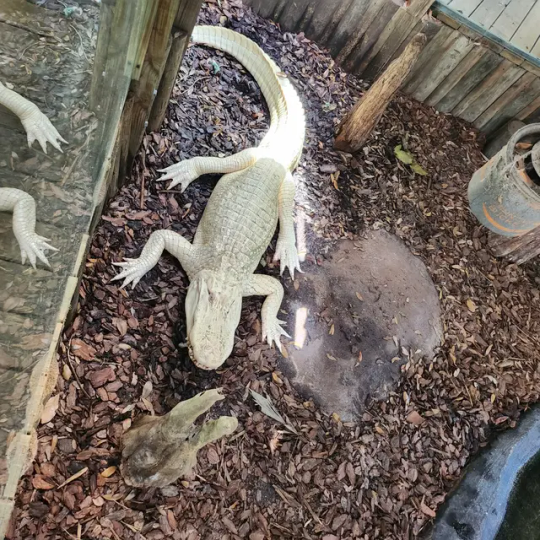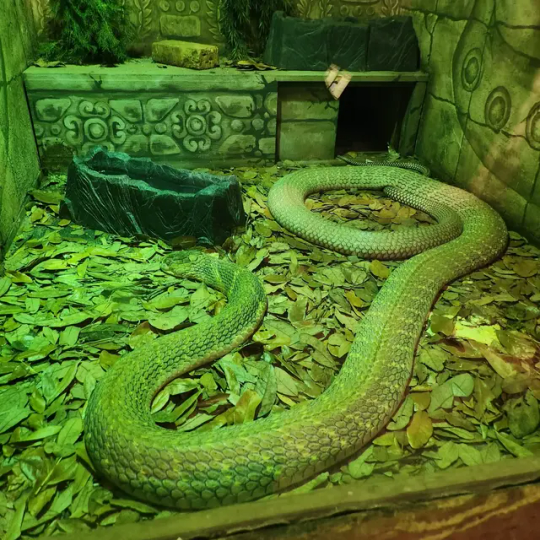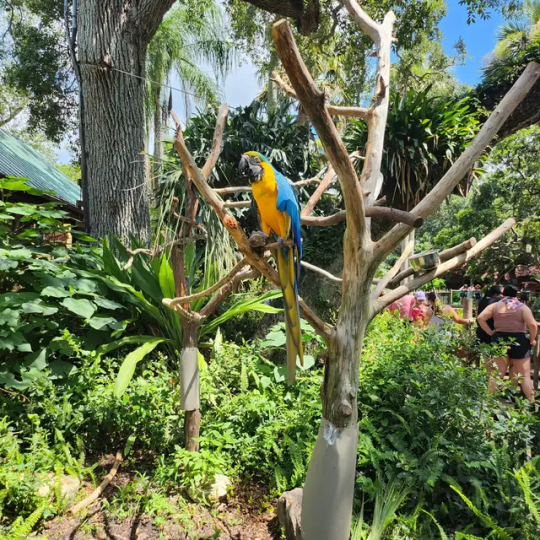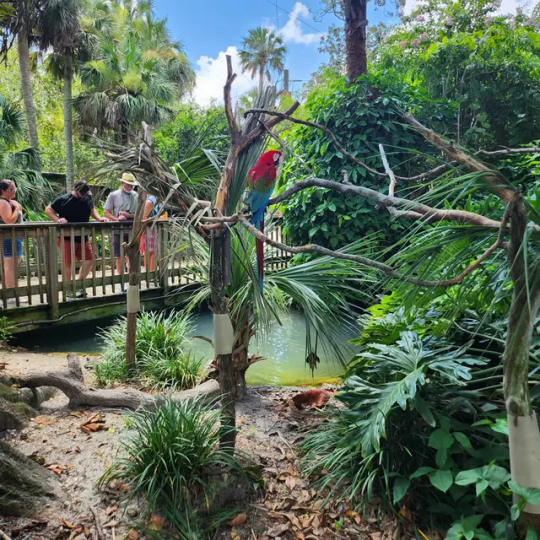#st augustine alligator farm
Note
Hey, I'm about 40 mins west of St. Augustine... is the Alligator Farm worth seeing with my young adult kids? Thanks for any input you have:)
Absolutely huge yes! The Alligator farm is legitimately one of my favorite places to visit and I think anyone could enjoy a day there. It’s a little unique as a zoo because there is much more focus on reptiles and birds than on mammals (though they have mammals too!). If your kids have even a whisper of interest in crocodilians and birds they will be in total heaven. The AF rookery is probably the best place in Florida to see nesting spoonbills so a visit during the spring and early summer is a must if you have any bird enthusiasts in the mix.
I can also personally attest to the high quality of care provided to animals at this facility. I did some field work there in vet school and was constantly blown away by the individualized care for even their tiniest of critters. The Alligator Farm was also the first zoo in the United States to get a perfect score from the AZA- which is an amazing accomplishment! You can be confident that the animals you’re visiting are in really great hands, which means a lot.
If you get a chance to go I’d recommend catching one of the feedings with their saltie Maximo, he’s an amazing animal.


#asks#st augustine alligator farm#sorry to gush but this is my favorite zoo!#really lovely place with people who have devoted their lives to crocodilians
158 notes
·
View notes
Text
does anyone. who has ever been to St Augistines Alligator Farm. have pictures of makara, the baby gharial who hatched in 2016. i am not lying when i say i will pay money to see pictures of these. please show me my girl.
5 notes
·
View notes
Text
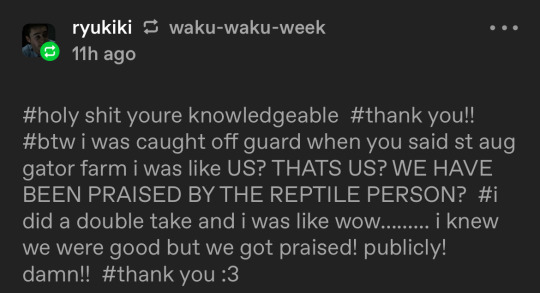
Aug ABSOLUTELY deserves the praise, @ryukikit. St. Augustine Alligator Farm is one of my favorite animal facilities, hands down. It's a pretty zoo, doable in an afternoon if you kinda like crocodilians, or an all day affair if you REALLY like crocodilians. Here are my favorite things about it and why I think it's worth supporting.
1. They keep animals in interesting social groups.

Crocodilians are heavily involved parents, but most places that breed them don't have the enclosure space to let the babies stay with the parents. St. Augustine does. One of my favorite groups was their crèche of slender-snouted crocodiles. They had the parents and then a yearling cohort and a new hatchling cohort. This aligns with how these guys live in the wild- the babies stick around longer! They have the space for it, and they are very in tune with the social needs of their animals.
Very, very few zoos can keep their baby crocs with the adults and still perform maintenance and animal health checks safely. This doesn't mean these facilities are bad- it just means that they have different management practices. And frankly, a lot of these species aren't frequently bred elsewhere. Your average zoo doesn't need a setup where you can have a multiyear crèche for slender-snouted crocodiles. Some species have better success when the young are pulled early, and some zoos are better set up to raise out any offspring separately or behind the scenes. Every facility's practices are different, and this just happens to work well at St. Augustine and be really enjoyable to see as a zoo patron.
Crocodilians are exceptional parents and very protective. It's a sign of incredible animal management practices and animals that feel very comfortable with staff that St. Augustine can do this with nearly every species they breed.
2. They understand the social needs of their animals.
Some crocodilians are social. Some are solitary. Some can live happily with a member of the opposite sex but get territorial around members of the same sex. St. Augustine pays incredible attention to their social groupings to ensure that they aren't just meeting the animals' physical health needs but their social needs as well. They do continuous scientific research about social structures in crocodilians, taking blood samples to test stress hormones and observing stress behaviors to see how group dynamics change.

For example, St. Augustine is home to one of the world's largest known living saltwater crocodiles, Maximo. And his comparatively tiny mate, Sydney. During the educational presentations with these two, they point out that even their monster of a croc needs his social group- he won't eat if she's not around and he is calmer during medical checks if he can see her. These animal share a deep and special pair bond, and they make sure to talk about how the social aspect of these animals' lives is integral to their care. It's a unique aspect of the way they talk about these animals, because he IS a spectacle and he IS a sensation, but they don't talk about him like he's a mindless killing machine- they talk about him like he's a big, complex predator with social needs like any other animal. Aug is the only facility I've been to where the emotional and social needs of crocodilians is part of the education they provide guests- and speaking of education...
3. Their demos and presentations are extremely good.
The presentations at St. Augustine are some of the best I've ever seen, and I've seen literally hundreds of animal talks on everything from aardvarks to zebras. But as you... can probably tell from my blog content, I've spent a lot of time learning about and working with reptiles. I really enjoyed all of their presentations because they are very scientific about things and avoid sensationalism. They really want you to be fascinated by these creatures and love them- but more than anything else, they want you to respect them.
Also, they do a really good job handling their ambassadors. I really enjoyed something as simple as watching an educator tell us about snakes. Throughout the whole presentation she made sure that most of the snake's body was looped in her hand. The snake was always supported and was very calm. She gave the snake plenty of head room so that it didn't feel constricted- it was just good handling all around.

But also, the presentations made it clear how much the park cares about the animals' well-being. When they do the feeding and training presentations, they make it very clear that the animals' participation is entirely voluntary. They do things differently for their 9-foot saltie and their 16-foot saltie, because the 16-footer is so large and heavy he actually struggles walking on land sometimes. They adapt their programs and his care to ensure that he's completely comfortable- and he didn't actually participate in the whole feeding when I was watching! At no point did they try to push him into anything uncomfortable; they offered, he didn't engage, and they moved on. It was a clear expression of his boundaries, and I really appreciated how much his caretakers respected that.
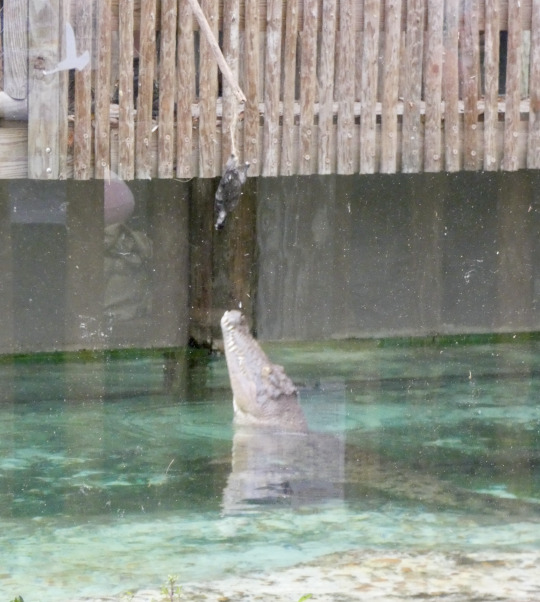
4. Ethical Interactions
I've been to... a lot of tourist locations in Florida that have animals you can hold. Almost always against my will! Many of them are pretty terrible, and you don't actually learn much, if anything. But I really found that to not be the case at St. Augustine. Every single animal presentation and interaction opportunity was accompanied by education about the animal's biology, habits, and- crucially- their conservation status.
When I held a baby alligator at St. Augustine, the proctors- there were two, one to ensure I was holding the gator correctly and the other to educate- were very informative about the role alligators play in their ecosystem and their conservation history. The animals were all properly banded, and one of the two proctors was there to ensure that none of the baby alligators were uncomfortable. As soon as they started getting squirmy or tense, they were removed, unbanded, and taken to an off-exhibit area to relax. And when the babies age out of petting size, they just go in the lagoon to live with others of their species. I saw one upset alligator the entire time I was there, and he was clearly upset that his escape attempt was foiled by a keeper during my nursery tour.
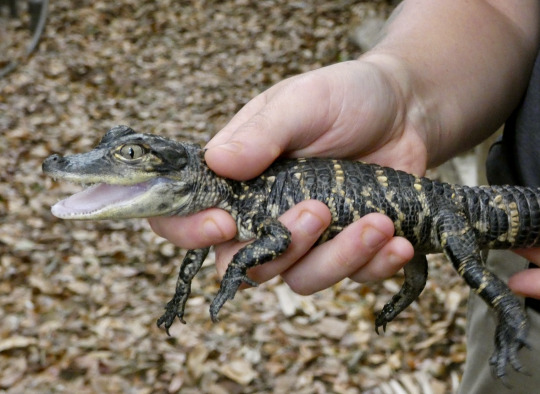
Even though he's restrained in this shot, you can see that his full body and tail are supported, and the grip, while firm, is gentle. He's distressed, but after I took this picture, she put him in his enclosure and he calmed down immediately.
Sometimes when you have petting attractions with baby animals, those animals... don't have a happy ending. (See: cub petting.) But St. Augustine's program is fine- the gators are all aged out of wanting to have mom around, there's no declawing/defanging, and they're handled with care. And it's worth it, because people love what they understand. St. Augustine was integral in raising public awareness about alligators back in the 60s when they were endangered, and now they're thriving- largely in part to programs like St. Augustine getting people to care.
And speaking of getting people to care, let's talk about their research.
5. Shared Research Results
St. Augustine is also home to more species of crocodilian than anywhere else in North America- all of them, usually. (They didn't have a Tomistoma when I visited- that may have changed.)
Because of this species diversity, it's an incredible research resource. Having every species means that you can do a lot of work comparing their behaviors, their growth patterns, and more. They've been a major research site for crocodilian biology since the 1970s. Today, they're one of the key sites for studying crocodilian play and social behaviors. They actually maintain a blog where they post copies of papers that were written using their animals, meaning that you can actually see the results of the research your admission helps fund. You can see that right here: https://www.alligatorfarm.com/conservation-research/research-blog/
All of this adds up to a zoo that provides a unique experience, tons of actual education, and transparency about what its research and conservation steps actually are. St. Augustine's come a long way since its opening in 1893, and they really do want you to leave with a new respect for the animals they care for. Ultimately, if you're a fan of reptiles, you can feel good about visiting the St. Augustine Alligator Farm- their care and keeping are top of the line, they do a ton of innovative conservation research and support for conservation organizations, and you can see this animal there:

(Gharial from the front. Nothing is wrong with her that's just what they look like from the front.)
6K notes
·
View notes
Link
1 note
·
View note
Text




Beetle cleaned reptile skulls and skeletons at the St. Augustine Alligator Farm. These skeletons were part of a display discussing poaching and how educational institutions process deceased animals for educational use.
151 notes
·
View notes
Text
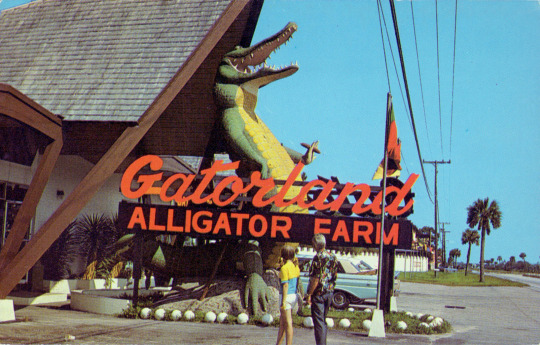
Gatorland Alligator Farm, St. Augustine, Florida
94 notes
·
View notes
Note
do you have any favourite hot snakes? obviously not to work with!
PSA for everyone - LEAVE THE VENOMOUS REPTILES TO THE PROFESSIONALS: DO NOT ATTEMPT TO INTERACT WITH VENOMOUS IF YOU’RE NOT SPECIFICALLY TRAINED AND SUPERVISED
Oh man do I. I’ll do three otherwise I’ll be here all day.
Boomslangs! Aka “Dispholidus Typus”.


[id: 1 green and yellow boomslang with black eyes, and 1 brown boomslang with bright green eyes]
Liddol guys! Look at their faces! What do you MEAN this cutie could kill me by making me essentially turn into a blood fountain, I don’t believe it. Maybe it’s worth it. They’re so beautiful too.
They’re colubrids (so the same family as kingsnakes, cornsnakes, hognoses etc), and while most colubrids aren’t venomous, there’s a few that absolutely are, and fewer still that can kill you. This particular snake has venom that’s a hemotoxin, meaning it causes just TONS of micro clots, which then makes it so that you can’t clot anymore and you hemorrhage and can start bleeding out of eyes, gums, etc. And it only takes a small amount of venom to be fatal to a fully grown human! Fortunately, all they want is to be left tf alone and biting is a last defence when they’re being harassed.
Samar Cobra “Naja Samarensis”



[id: black cobra with bright yellow markings and hood]
Look I tried to find pictures where they don’t look like an affronted shoelace but they just do. I love most cobras but look at their face. They’re like bro. Can I fucking HELP you. 100% is supported by the fact that they’re sketchy as fuck, if you look at them wrong they’re like you know what buddy, I’m gonna spit my venom at your eyeballs.
They’re elipads* that are indigenous to the Philippines, and despite being skeeved out by humans they like hanging around places like rice fields because it’s where things like rats like hanging out. Their venom causes a delightful number of effects like paralysis, respiratory distress, and necrosis if bitten, and if you’re unfortunate enough to get it in your eyes after being spat at, it can cause blindness as it wrecks your eyeball tissue. Fun!
* elapidae - snake family that have permanent fangs out, like this dude below, a king cobra that’s found their home at the St Augustine Alligator Farm in Florida!
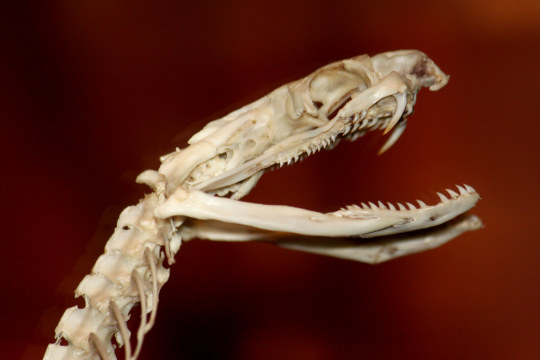
[id: skull of a king cobra]
Bush vipers!


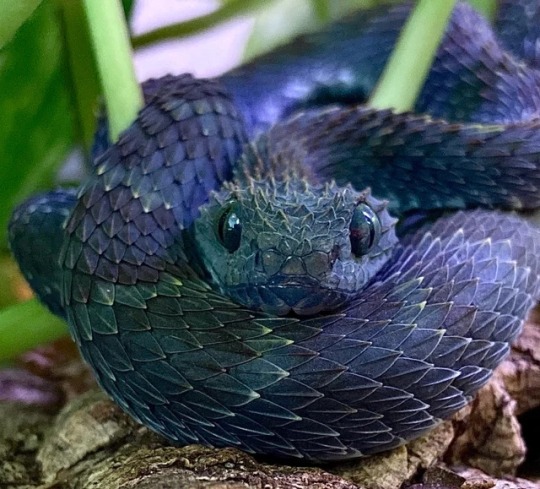
[id: 3 types of bush vipers; a brown and orange tia hairy bush viper, a bright green west African bush viper and a dark blue variable bush viper]
I can’t even choose a subtype. They’re legitimately one of my absolute favourite types of snake. I would kill I would DIE to be in the presence of one. They’re mini dragons! Mini extremely venomous dragons!
They’re from the viperidae family, which contain over 200 types of viper. Like the elapidae family, they’ve got fangs at the front and venom glands stored in their heads. Viperidae fangs are foldable back in their mouth rather than constantly having them locked to the front like elapidae, and viperidae fangs are longer, and there’s differences in the types of venom they have too. They also have one lung!
Bonus: gaboon viper. What is this. Ridiculous animal. He is TRUNDLING. Chugga chugga of death.
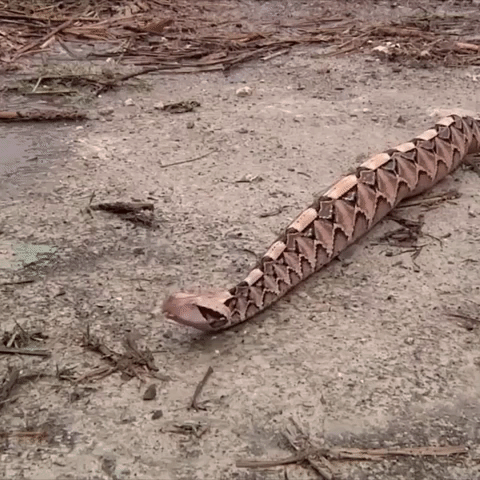
#I got too into this#juniper posts#adhd hyper focus strikes again#I learned a lot by researching while I was writing this thanks anon
54 notes
·
View notes
Text
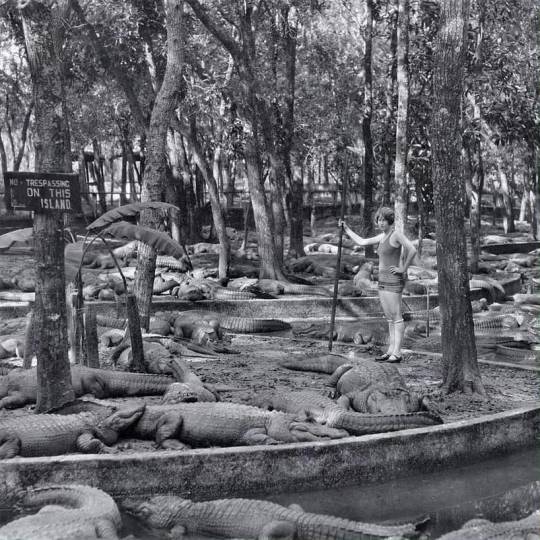
A woman tending to an Alligator Farm in St. Augustine, FL (1926). Backstory: https://bit.ly/3MOTGGW
16 notes
·
View notes
Text


An alligator at a Florida zoo was "behaving strangely" and exhibiting abnormal symptoms. Brooke, a 376-pound gator from St. Augustine Alligator Farm Zoological Park, was exhibiting a series of symptoms, including intermittent head-rolling. According to a statement by the University of Florida College of Veterinary Medicine, the experts there used all the diagnostic tools at their disposal, including a blood draw, lung X-rays, and CT scans of Brooke's head. The hospital noted that clinicians had to use both X-rays and CT scans because "Brooke was too large to perform a complete CT scan of his body." With all that information at their fingertips, the team soon made a diagnosis: Brooke had an ear infection. They can be very painful. The zoo said that Brooke would receive medicine "without any stress or worry." Brooke has years of experience coming when called, accepting food (sometimes with medicine), and holding still," the zoo wrote.
Awwwwwwwwwwww, poor baby. I know what an ear ache feels like.
8 notes
·
View notes
Text
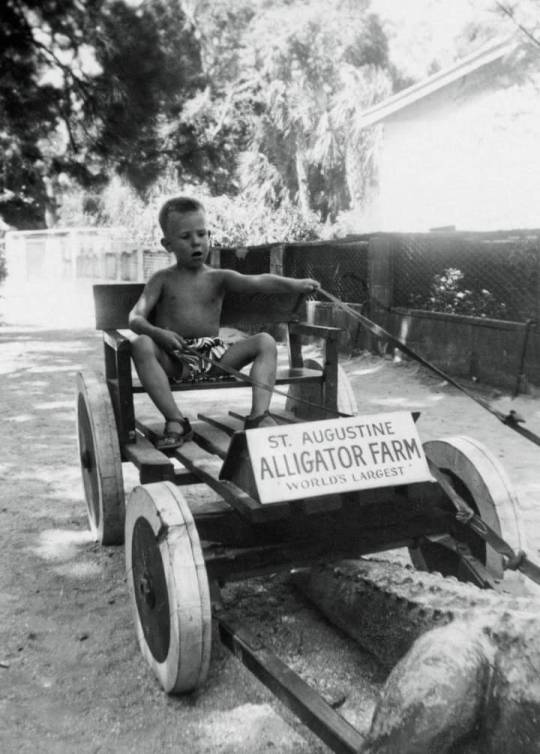
Hank Williams Jr being pulled by an alligator at the St Augustine Alligator Farm in St Augustine Florida. Photo courtesy of J.D Thomas
4 notes
·
View notes
Text
Hands down my fave thing about hurricane season is when zoos put their birds in the bathroom to protect them from the wind and we get images like this

Photo from St Augustine Alligator Farm
88K notes
·
View notes
Note
IT'S HAPPENING I AM GOING TO ST AUGUSTINE ALLIGATOR FARM! I will do my best to get Makara photos for you!
I am so sorry but I recently learned that Makara has passed away :( :( :(
but I would still be so crazy grateful for any gharial pictures you can get!!!
you are so extremely kind- thank you <3
6 notes
·
View notes
Text
Empress scorpion. Alligator skull sourced from St Augustin Alligator farm & rescue.


1 note
·
View note
Text
HBO War Florida Vacation Prompts
Alright guys, I have officially come to the realization that THERE IS NO WAY IN FUCKING HELL that I’m gonna quit writing. Sure, sometimes you need a break once in a while, but to anybody who has ever been in a situation where you wanted to quit out of fear, to quote the film Lone Survivor, “Whatever you have to do.....just find an excuse to win.....keep going.” Anywho, I’ve got a fresh round of prompts for you guys so go nuts!!!! lol
1. Taking the kids to Disney for the first time
2. Cheeseburger in Paradise (Songfic)
3. Exploring the Everglades
4. Key West
5. Beachside in Miami
6. Fishing
7. Taking the Kids to Universal Orlando
8. Kennedy Space Center
9. Busch Gardens
10. Going to the Daytona 500
11. St Augustine
12. Watching the space shuttle launch
13. Swimming with sea critters
14. Going to a Florida State Seminoles Game
15. Spring Break
16. Tequila sunrise
17. Sex on the beach
18. Conch shells
19. Rainstorm
20. Banana Crate
21. Seeing a drag show in Miami
22. Alligators
23. Orange farms
24. Loaded with Sunshine
25. Space Camp
26. Diving for treasure
27. Our own little island
28. Swimming with the manatees
29. “It’s not a duck, it’s a PELICAN!!”
30. Surf’s up
31. Sanibel Island
32. One night in Little Havana
33. “I think we’re in Florida Man territory”
34. Legoland
35. Aviation museum
36. Sea World
37. Weeki Wachi River kayaking
38. Dancing under the palms
39. First night in the hotel
40. Baseball game
#band of brothers#the pacific hbo#generation kill#hbo war#hbo war prompts#hbo war au#inbox is always open#ask away
2 notes
·
View notes
Text



Crocodilian skulls from the St. Augustine Alligator Farm. Two large adult Nile crocodiles (Crocodylus niloticus, top and bottom left) and a large adult saltwater crocodile (Crocodylus porosus). These two species are some of the largest true crocodiles to have ever existed. Nile crocodiles are found throughout most of Africa while saltwater crocodiles are found in the Indian subcontinent, Southeast Asia, Indonesia, Papua New Guinea, the Philippines, and northern Australia.
71 notes
·
View notes
